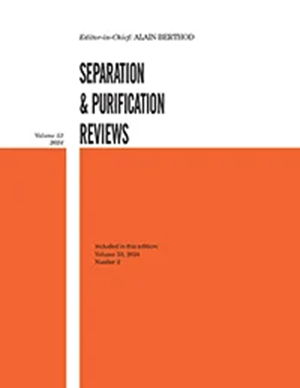Simulations of Physically Surface-Patterned Membranes for Water Treatment: Recent Advances
IF 5.6
2区 工程技术
Q1 CHEMISTRY, ANALYTICAL
引用次数: 0
Abstract
ABSTRACTSurface-patterned membranes are becoming increasingly attractive for reducing fouling in membrane processes for water treatment. In this review article, literature on simulations of physically surface-patterned membranes is reviewed, with emphasis on the various factors affecting their anti-fouling performance. Associated computational techniques, including computational fluid dynamics and Brownian dynamics, are discussed. Key parameters discussed in the literature include the dimensions of the membrane (height, width), the velocity and direction of the fluid flow, the size of the particles, and the pattern size (height, width, and pitch). The key observables are the shear stress and velocity streamlines at various points, especially the pattern apex and valley regions, with an un-patterned membrane as a point of comparison in studies. The review concludes that the pattern dimensions have the most significant influence on the anti-fouling performance. Also, the effect of particle size to membrane pattern ratio on the extent of particle deposition on the membrane (fouling activity) can be explained by understanding the shear stress distribution around the membrane.KEYWORDS: Patterned membraneanti-foulingsimulationComputational fluid dynamics (CFD)Brownian dynamics (BD) AcknowledgmentsDC is thankful to the Ministry of Education, India, for providing research fellowship.Disclosure statementNo potential conflict of interest was reported by the author(s).物理表面图案膜在水处理中的模拟:最新进展
表面图案膜在减少水处理膜工艺中的污染方面越来越有吸引力。在这篇综述文章中,对物理表面图案膜的模拟文献进行了综述,重点介绍了影响其抗污染性能的各种因素。相关的计算技术,包括计算流体动力学和布朗动力学,进行了讨论。文献中讨论的关键参数包括膜的尺寸(高度、宽度)、流体流动的速度和方向、颗粒的大小和图案尺寸(高度、宽度和节距)。关键的观测值是各点的剪应力和速度流线,特别是图案顶点和山谷区域,研究中以非图案膜作为比较点。研究表明,图案尺寸对防污性能的影响最为显著。此外,粒径与膜纹比对颗粒沉积在膜上的程度(污染活性)的影响可以通过理解膜周围的剪切应力分布来解释。关键词:图纹膜;防污染模拟;计算流体动力学(CFD);布朗动力学(BD)致谢dc感谢印度教育部提供的研究资助。披露声明作者未报告潜在的利益冲突。
本文章由计算机程序翻译,如有差异,请以英文原文为准。
求助全文
约1分钟内获得全文
求助全文
来源期刊
CiteScore
12.20
自引率
1.90%
发文量
24
审稿时长
6 months
期刊介绍:
Separation & Purification Reviews provides comprehensive summaries and interdisciplinary viewpoints of significant developments in all areas of separation and purification, including innovative methods, apparatus, theories, and applications. The journal presents reviews that cover a large amount of scientific/technical information in a concise and organized manner on topics such as adsorption, centrifugation, chromatography, crystallization, distillation, extraction, filtration, ion exchange, membrane separations of solid, liquid or gaseous materials.

 求助内容:
求助内容: 应助结果提醒方式:
应助结果提醒方式:


